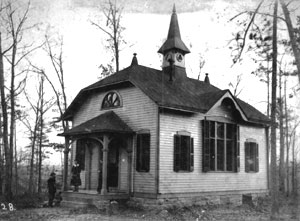
Rugby
A Victorian-era village at the northern tip of Morgan County, Rugby was founded by a company of British and American capitalists who cleverly traded on the popularity of Thomas Hughes, a noted English author and social reformer of the time, to draw attention to their real estate venture, later described as “the last attempt at English colonization in America.”
Hughes, a lawyer and one-time member of Parliament, had gained a high level of name recognition and visibility on both sides of the Atlantic for his 1857 novel, Tom Brown’s School Days, based loosely upon his own experiences at Rugby, a famous English school for boys. On a visit to the United States in 1870, he was struck by the relative ease with which young graduates of American schools moved into the broad world of work. In contrast, English schools catered almost exclusively to the sons of the upper class, who subsequently could engage in only a few elite callings, all other work being considered beneath them.
The idea for a new American colony integrated across various social barriers began to take shape in the idealistic English writer’s mind, and in 1879 he became the central public figure in an Anglo-American company made up of a few wealthy Englishmen and a group of Boston capitalists who owned a large tract of land in East Tennessee. The Bostonians had acquired the property–seventy-five thousand acres, with options on another three hundred thousand–as a relocation site for unemployed New Englanders idled by an industrial depression, but improved economic conditions had lessened interest in the venture.
With Hughes in the forefront, the developers, incorporated as the Board of Aid to Land Ownership, proceeded to make the most of a novel concept: aristocratic young Brits and energetic young Yanks working in harmony to build a model community–and, what’s more, on southern soil. Given the recent Civil War and the long history of conflict between Great Britain and its former colony, the prospects for a symbolic reconciliation and reunion in the new Tennessee village attracted broad public interest.
By the time Rugby was officially christened on October 5, 1880, the rising village had become home to a handful of young English colonists and an interesting mix of others, perhaps 100 people in all. The Tabard Inn, named for the celebrated hostelry in Chaucer’s Canterbury Tales, welcomed guests and temporary residents, and Christ Church, a backwoods outpost of the Church of England, brought an exotic new air of pomp and antiquity to the religious ambiance of the Cumberland Plateau. Homes and boarding houses and public buildings–most notably, a fine new library soon to be stocked with Victorian first editions–also were coming along. Almost from the start, Rugby had a look and feel of permanence.
The population grew to about 300 residents by the summer of 1881. Privileged young Englishmen were the most visible in press reports of the colony, but they never were a majority; in fact, Americans outnumbered all Europeans from the start. Men and women from the North and South, and from the Tennessee mountains in between, were joined by men and women from France and Germany as well as England. Thomas Hughes frequently expressed his desire “to have [a positive] influence with the poor whites and blacks,” and his reconciling, inclusive spirit pervaded the utopian community.
But in Rugby, as in all Edens, snakes lurked in the shadows. In the late summer of 1881, a typhoid fever epidemic claimed the lives of 7 settlers. Many residents of Rugby pulled up stakes and left in panic; by the end of the year, only about 60 people remained. With gradual recovery over the next few years, the population rebounded to about 450, and there were sixty-five homes and other buildings in use–but then the Tabard Inn was destroyed by fire, and all of the various plans for industry and agriculture to sustain the colony financially proved to be ineffective. Land sales never reached expectations, legal problems cropped up, and the school that was to have been the pride of the English Rugby never reached its potential.
Inevitably, the high-born Englishmen were blamed for virtually every shortcoming, they and Thomas Hughes, but in truth it was the profit-driven English and American investors whose poor judgment had been most costly. They had tried to micromanage the community from London and Boston, and in so doing tied the hands of the resident leaders and managers who struggled in vain to keep the community afloat. Hughes visited Rugby almost every year through 1887 but never lived there (though his mother and brother did). In 1892, when he was past seventy and his would-be utopia was past saving, he expressed in a letter to one of the residents his abiding faith “that good seed was sown when Rugby was founded and that someday the reapers will come along with joy, bearing heavy sheaves with them.”
Nothing so grand ever transpired. But in 1966 a small group of interested Tennesseans established the Rugby Restoration Association to save the historic church and library and other remaining buildings, and under the leadership of seventeen-year-old Brian Stagg of the nearby Deer Lodge community, the organization began a process that is now bearing significant fruit. Historic Rugby is a residential community once again, and an important tourist attraction as well. The long-ago dreams of Thomas Hughes and the more recent visions of the late Brian Stagg have not been in vain.
Suggested Reading
John Egerton, Visions of Utopia: Nashoba, Rugby, Ruskin and the “New Communities” in Tennessees Past (1977)



